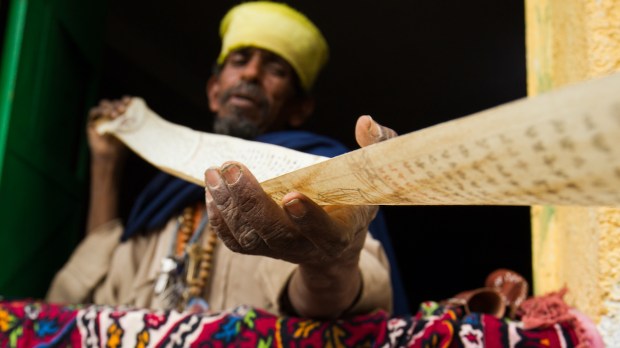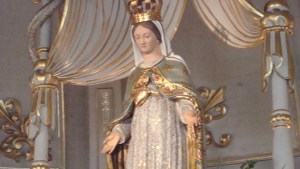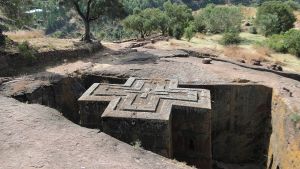There’s a story dating from the 14th century that is recited in Ethiopian and Eritrean monasteries. It speaks of a nobleman from the city of Qemer who was a cannibal. One day, he was approached by a leper who begged for water. The nobleman refused three times, but when the beggar asked a fourth time, this time asking in the name of the Blessed Virgin Mary, the nobleman gave him a handful of water.
“When the nobleman died and the angels of darkness came to take him to Sheol, Mary declared that his soul belonged to her, for he had given charity in her name,” the story goes.
She begged Christ to have mercy on the nobleman’s soul, and the Lord commanded that the man’s sins be weighed against his good deeds.
“Angels of light weighed the souls of those the nobleman had eaten against the handful of water he had given the beggar, and the water weighed more,” the story says. “He was saved.”
For laity and researchers
Dating from around the year 1375, this is one of hundreds of stories that are collected by Princeton University at a website called Princeton Ethiopian, Eritrean and Egyptian Miracles of Mary (PEMM).
According to Wendy Laura Belcher, professor of comparative literature and African American studies at Princeton, there are more than 1,000 monasteries and 15,000 churches in Ethiopia and Eritrea. Nearly every one has Marian stories contained in a compilation text called the “Täˀammərä Maryam” (Miracles of Mary), used daily for prayer and read aloud during liturgies.
The PEMM website features more than 1,000 stories, 2,500 paintings and 1,000 digitized parchment manuscripts in which the stories appear. It’s designed to be inspirational for the average lay reader and a source of information for researchers.
“The easy-to-navigate PEMM website includes over 2 million pieces of painstakingly collected data documenting the development of these Marian stories, from the very beginning, to their flourishing in Africa in the middle ages, into the present day,” according to Princeton.
Number one story subject
Belcher contends that stories about the Blessed Virgin Mary “have been told by more people, over more centuries, in more countries, and in more languages” than stories about “anyone else ever.” In Europe, “Miracles of Mary” stories began to circulate in the 11th century.
But the African tradition of Marian miracle stories is even older, going back to the 200s, Belcher and her fellow researchers have found.
As many as 100,000 “Täˀammərä Maryam” manuscripts exist in Ethiopia, yet only a handful of them and their stories had been cataloged or translated into English. The PEMM project has access to 1,000 digital copies, many of them microfilmed in the 1970s and ‘80s, Belcher said, when the National Endowment for the Humanities provided funding for people to go into monasteries and churches to do this work.
The PEMM project began at the Princeton University Library, which has the largest collection of Ethiopian manuscripts in the Americas and an unusually high number of Täˀammərä Maryam manuscripts.
Belcher estimates that only three institutions outside of Ethiopia have more: the British Library, the Bibliothèque nationale de France, and the Vatican.



